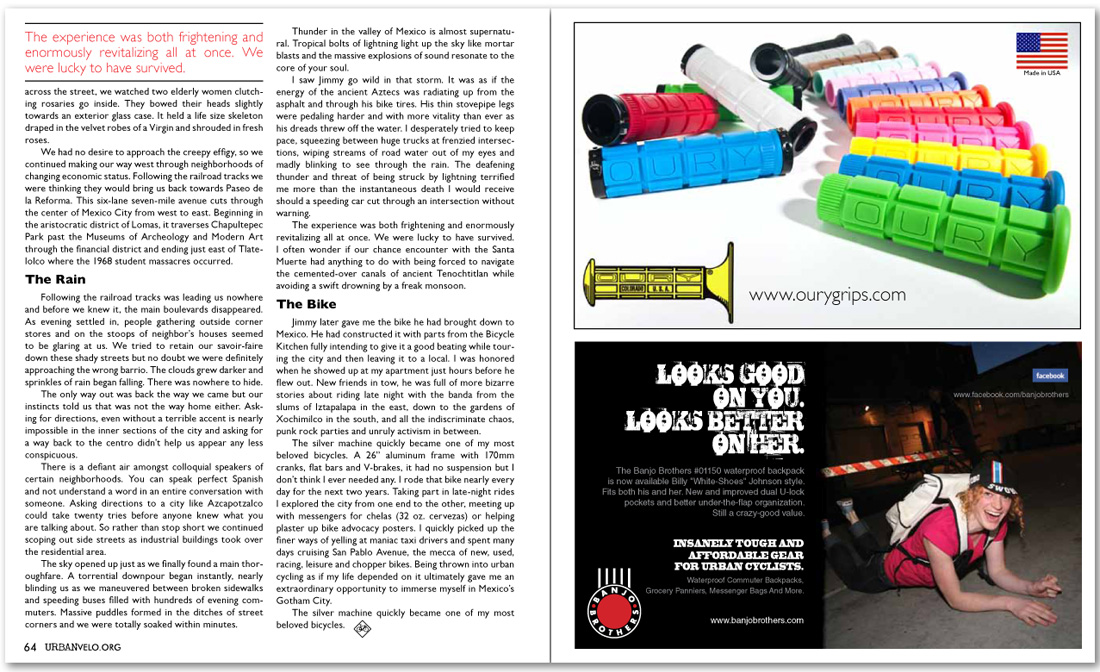


across the street, we watched two elderly women clutching rosaries go inside. They bowed their heads slightly towards an exterior glass case. It held a life size skeleton draped in the velvet robes of a Virgin and shrouded in fresh roses.
We had no desire to approach the creepy effigy, so we continued making our way west through neighborhoods of changing economic status. Following the railroad tracks we were thinking they would bring us back towards Paseo de la Reforma. This six-lane seven-mile avenue cuts through the center of Mexico City from west to east. Beginning in the aristocratic district of Lomas, it traverses Chapultepec Park past the Museums of Archeology and Modern Art through the financial district and ending just east of Tlatelolco where the 1968 student massacres occurred.
The Rain
Following the railroad tracks was leading us nowhere and before we knew it, the main boulevards disappeared. As evening settled in, people gathering outside corner stores and on the stoops of neighbor’s houses seemed to be glaring at us. We tried to retain our savoir-faire down these shady streets but no doubt we were definitely approaching the wrong barrio. The clouds grew darker and sprinkles of rain began falling. There was nowhere to hide.
The only way out was back the way we came but our instincts told us that was not the way home either. Asking for directions, even without a terrible accent is nearly impossible in the inner sections of the city and asking for a way back to the centro didn’t help us appear any less conspicuous.
There is a defiant air amongst colloquial speakers of certain neighborhoods. You can speak perfect Spanish and not understand a word in an entire conversation with someone. Asking directions to a city like Azcapotzalco could take twenty tries before anyone knew what you are talking about. So rather than stop short we continued scoping out side streets as industrial buildings took over the residential area.
The sky opened up just as we finally found a main thoroughfare. A torrential downpour began instantly, nearly blinding us as we maneuvered between broken sidewalks and speeding buses filled with hundreds of evening commuters. Massive puddles formed in the ditches of street corners and we were totally soaked within minutes.
Thunder in the valley of Mexico is almost supernatural. Tropical bolts of lightning light up the sky like mortar blasts and the massive explosions of sound resonate to the core of your soul.
I saw Jimmy go wild in that storm. It was as if the energy of the ancient Aztecs was radiating up from the asphalt and through his bike tires. His thin stovepipe legs were pedaling harder and with more vitality than ever as his dreads threw off the water. I desperately tried to keep pace, squeezing between huge trucks at frenzied intersections, wiping streams of road water out of my eyes and madly blinking to see through the rain. The deafening thunder and threat of being struck by lightning terrified me more than the instantaneous death I would receive should a speeding car cut through an intersection without
warning.
The experience was both frightening and enormously revitalizing all at once. We were lucky to have survived. I often wonder if our chance encounter with the Santa Muerte had anything to do with being forced to navigate the cemented-over canals of ancient Tenochtitlan while avoiding a swift drowning by a freak monsoon.
The Bike
Jimmy later gave me the bike he had brought down to Mexico. He had constructed it with parts from the Bicycle Kitchen fully intending to give it a good beating while touring the city and then leaving it to a local. I was honored when he showed up at my apartment just hours before he flew out. New friends in tow, he was full of more bizarre stories about riding late night with the banda from the slums of Iztapalapa in the east, down to the gardens of Xochimilco in the south, and all the indiscriminate chaos, punk rock parties and unruly activism in between.
The silver machine quickly became one of my most beloved bicycles. A 26” aluminum frame with 170mm cranks, flat bars and V-brakes, it had no suspension but I don’t think I ever needed any. I rode that bike nearly every day for the next two years. Taking part in late-night rides I explored the city from one end to the other, meeting up with messengers for chelas (32 oz. cervezas) or helping plaster up bike advocacy posters. I quickly picked up the finer ways of yelling at maniac taxi drivers and spent many days cruising San Pablo Avenue, the mecca of new, used, racing, leisure and chopper bikes. Being thrown into urban cycling as if my life depended on it ultimately gave me an extraordinary opportunity to immerse myself in Mexico’s Gotham City.
The silver machine quickly became one of my most beloved bicycles.